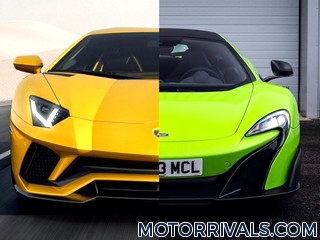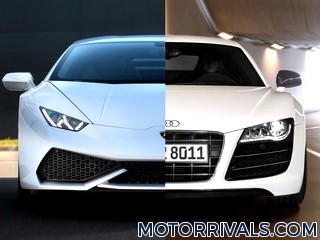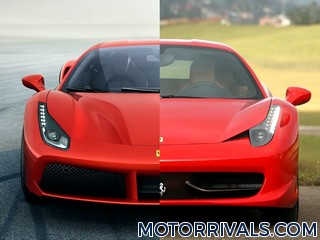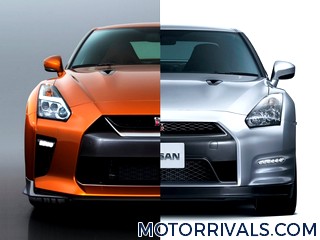2017 Lamborghini Aventador S vs 2017 Lamborghini Huracan
Lamborghini Press Release Highlights
The new Lamborghini Aventador S is characterized by new aerodynamic design, redeveloped suspension, increased power and new driving dynamics. The 'S' is the suffix of previous enhanced Lamborghini models and defines a new benchmark for the V12 Lamborghini. The design of the new Lamborghini Aventador S clearly indicates the new Aventador generation. The Aventador S features a number of exterior developments, particularly in front and rear, while its profile remains clearly an Aventador. Every modified component is redesigned for a purpose, achieving maximum aerodynamic efficiency while accenting the Aventador's complex, muscular dynamism. Furthermore, Lamborghini Centro Stile has intelligently integrated certain elements of past icons, such as the lines of rear wheel arches reminiscent of the original Countach.
The Lamborghini Aventador S design results in significantly enhanced aerodynamic performance. Front downforce has been improved by more than 130% over the previous Aventador coupé. When the wing is in its optimum position the overall efficiency at high downforce is improved by over 50%, and in low drag by more than 400% compared to the previous model.
A dry weight of just 1,575 kg provides a weight-to-power ratio of just 2.13 kg/hp. Acceleration from 0-100 km/h is reached in 2.9 seconds, with a top speed of 350 km/h. Transmission is provided by Lamborghini's lightweight Independent Shifting Rod (ISR) 7-speed shifting system, providing robotized gear shifts in up to 50 milliseconds.
The Aventador S adopts a new exhaust system developed as the result of a significant R&D project. More than 20% lighter than its predecessor and the product of testing multiple configurations, the results are an enhanced Lamborghini sound and resonance from the already inimitable V12 aspirated engine, with the three single pipe outlets at the rear of the Aventador S a visual reminder of the new exhaust system.
As in its predecessor, the Lamborghini Aventador S is equipped with a stop-and-start system and cylinder deactivation for optimized engine efficiency. When full engine capacity is not required, six of the twelve cylinders are temporarily deactivated by switching off one cylinder bank. When the driver accelerates, the system switches back instantaneously to twelve-cylinder mode, with the changeover virtually impossible to detect by the driver.
Enhanced lateral control comes from new four-wheel steering, which provides improved agility at low and medium speeds and more stability at high speed. On the front axle it is combined with Lamborghini Dynamic Steering (LDS), tuned for a more natural and responsive feel with a sharper turn-in. It is specially adapted to integrate with the active Lamborghini Rear-wheel Steering (LRS) on the rear axle allowing a real-time angle and cornering stiffness adjustment.
Vertical control comes from Lamborghini's updated pushrod and Lamborghini Magneto-rheological Suspension (LMS), with revised kinematics adapted to the new four-wheel steering. New suspension geometry, optimized for Lamborghini Rear-wheel Steering, includes upper and lower arm and wheel carrier to reduce caster and load on the system. A new real-time variable damping system optimizes wheel and body control, and balance and ground stiffness is maximized. New rear springs also enhance the car's balance.
Lamborghini engineers have integrated the smart Lamborghini Dinamica Veicolo Attiva (LDVA) control unit to manage these systems in the car. Carbon ceramic brakes are standard equipment for the Aventador S. The ventilated and perforated carbon ceramic discs (Ø 400 x 38 mm - Ø 380 x 38 mm) enhance braking performance from 100 km/h to standstill in 31 m.
The Lamborghini telemetry system is an optional specification: recording lap times and track performance as well as trip data, the telemetry system is especially appealing to the owner who wants to take his car on track. AppleCarPlay comes as a standard specification, allowing the cockpit's occupants to manage voice activated communications and entertainment from personal Apple devices.
The Lamborghini Aventador S design results in significantly enhanced aerodynamic performance. Front downforce has been improved by more than 130% over the previous Aventador coupé. When the wing is in its optimum position the overall efficiency at high downforce is improved by over 50%, and in low drag by more than 400% compared to the previous model.
Powertrain
The Lamborghini Aventador's naturally aspirated twelve cylinder, 6.5 liter engine outputs an additional 40 hp over its predecessor, to a maximum 740 hp, with a 690 Nm of torque at 5,500 rpm. To achieve the power increase, both VVT (Variable Valve Timing) and VIS (Variable Intake System) have been optimized in order to obtain an enriched torque curve. Additionally, the maximum engine revs have been increased from 8,350 to 8,500 rpm.A dry weight of just 1,575 kg provides a weight-to-power ratio of just 2.13 kg/hp. Acceleration from 0-100 km/h is reached in 2.9 seconds, with a top speed of 350 km/h. Transmission is provided by Lamborghini's lightweight Independent Shifting Rod (ISR) 7-speed shifting system, providing robotized gear shifts in up to 50 milliseconds.
The Aventador S adopts a new exhaust system developed as the result of a significant R&D project. More than 20% lighter than its predecessor and the product of testing multiple configurations, the results are an enhanced Lamborghini sound and resonance from the already inimitable V12 aspirated engine, with the three single pipe outlets at the rear of the Aventador S a visual reminder of the new exhaust system.
As in its predecessor, the Lamborghini Aventador S is equipped with a stop-and-start system and cylinder deactivation for optimized engine efficiency. When full engine capacity is not required, six of the twelve cylinders are temporarily deactivated by switching off one cylinder bank. When the driver accelerates, the system switches back instantaneously to twelve-cylinder mode, with the changeover virtually impossible to detect by the driver.
Chassis
Four masterpieces evolve driving emotion: Four-wheel drive, new active suspension, new four-wheel steering system and the new EGO driving mode. The Lamborghini Aventador S chassis retains the Aventador's unique and extremely rigid lightweight carbon fiber monocoque with attached aluminum frames resulting in a dry weight of just 1,575 kg. The Aventador S allows the driver to select between four different driving modes: STRADA, SPORT, CORSA and the new EGO mode, which influence the behavior of traction (engine, gearbox, 4WD), steering (LRS, LDS, Servotronic) and suspension (LMS). All driving modes have been recalibrated in the Lamborghini Aventador S, improving ESC integration with all-wheel drive and the interface between engine torque management system and traction control reaction.Enhanced lateral control comes from new four-wheel steering, which provides improved agility at low and medium speeds and more stability at high speed. On the front axle it is combined with Lamborghini Dynamic Steering (LDS), tuned for a more natural and responsive feel with a sharper turn-in. It is specially adapted to integrate with the active Lamborghini Rear-wheel Steering (LRS) on the rear axle allowing a real-time angle and cornering stiffness adjustment.
Vertical control comes from Lamborghini's updated pushrod and Lamborghini Magneto-rheological Suspension (LMS), with revised kinematics adapted to the new four-wheel steering. New suspension geometry, optimized for Lamborghini Rear-wheel Steering, includes upper and lower arm and wheel carrier to reduce caster and load on the system. A new real-time variable damping system optimizes wheel and body control, and balance and ground stiffness is maximized. New rear springs also enhance the car's balance.
Lamborghini engineers have integrated the smart Lamborghini Dinamica Veicolo Attiva (LDVA) control unit to manage these systems in the car. Carbon ceramic brakes are standard equipment for the Aventador S. The ventilated and perforated carbon ceramic discs (Ø 400 x 38 mm - Ø 380 x 38 mm) enhance braking performance from 100 km/h to standstill in 31 m.
Technology
The cockpit of the Aventador S brings new functionality and refinement. A new TFT digital dashboard can be customized according to the driver's preferences, with different kombi screens for STRADA, SPORT and CORSA in conjunction with the EGO mode. Selected from the driving modes options on the control panel, the EGO button reveals further options on pop-up digital screens, allowing the driver to choose his preferred settings.The Lamborghini telemetry system is an optional specification: recording lap times and track performance as well as trip data, the telemetry system is especially appealing to the owner who wants to take his car on track. AppleCarPlay comes as a standard specification, allowing the cockpit's occupants to manage voice activated communications and entertainment from personal Apple devices.
Lamborghini Press Release Highlights
Automobili Lamborghini is taking a major step into the future: with the
newly developed Huracán LP 610-4, the successor to the highly successful
Gallardo, the Italian super sports car manufacturer is redefining the
benchmark in the segment. With its pure and absolute design,
breathtaking dynamics and excellent quality, the Huracán delivers an
unparalleled sports car experience. It unites mighty performance with a
character perfectly suited to everyday use; its wide-ranging new
technologies work together in a fully integrated fashion. Stephan
Winkelmann, President and CEO of Automobili Lamborghini said: "With the
Huracán, Lamborghini is writing the next chapter in its great history."
With the Huracán LP 610-4, Lamborghini is taking its purist, unmistakable design language to a whole new evolutionary level. The design is bold and edgy, with beautifully sculptural forms. The starting point of the design process was the Huracán's silhouette. The objective was to define the car with a single line stretching from the front end over the passenger cell to the rear. The side windows take on a hexagonal form that looks like a gem set into the profile of the Huracán. At night, too, it is utterly unmistakable: All lights, including the main headlamps, beam in LED technology - an absolute first in the super sports car segment.
An innovative cockpit dominates the interior. The 12.3-inch TFT display can be configured in a number of different modes and provides the driver with all key information in a virtual format. The slender lines of the instrument mounts and the center tunnel are indicative of the lightness of the interior design. Fine materials distinguish the interior, which can be extensively individualized, while the extremely detailed craftsmanship delivers a highly refined sense of quality.
The newly conceived hybrid chassis of the Huracán LP 610-4 is a technical work of art that unites carbon-fiber and aluminum components. The ultralight chassis forms the basis for the vehicle’s low dry weight of 1,422 kilograms; with its excellent stiffness, it guarantees the handling precision of a racing car.
The new V10 engine in the Huracán generates its phenomenal propulsion from a displacement of 5.2 liters. It produces a power output of 448 kW / 610 hp at 8,250 rpm and a maximum torque of 560 Nm at 6,500 rpm. The new "Iniezione Diretta Stratificata" combines direct and indirect injection - achieving an increase in power and torque compared with the Gallardo and a decrease in fuel consumption and emissions.
With its power-to-weight ratio of just 2.33 kilograms per hp, the Lamborghini Huracán achieves absolutely breathtaking performance. The top speed of more than 325 km/h and the acceleration figures - zero to 100 km/h in 3.2 seconds, zero to 200 km/h in 9.9 seconds – offer an indication of its dynamics. Thanks in part to the Stop & Start technology, ECE average fuel consumption has dropped to 12.5 liters per 100 km (290 g CO2 per km).
The power generated by the ten-cylinder is delivered to the road via the new 7-speed dual-clutch transmission "Lamborghini Doppia Frizione" (LDF) and an all-wheel drive that also features a new hydraulic multi-plate clutch. Three different driving modes, spanning from road to race track, can be selected using a drive select switch in the steering wheel. The system is called ANIMA (Italian for Soul) - "Adaptive Network Intelligent Management", and impacts the engine, the transmission, the all-wheel drive and the ESC handling system as well as other dynamic systems.
With the Huracán LP 610-4, Lamborghini is taking its purist, unmistakable design language to a whole new evolutionary level. The design is bold and edgy, with beautifully sculptural forms. The starting point of the design process was the Huracán's silhouette. The objective was to define the car with a single line stretching from the front end over the passenger cell to the rear. The side windows take on a hexagonal form that looks like a gem set into the profile of the Huracán. At night, too, it is utterly unmistakable: All lights, including the main headlamps, beam in LED technology - an absolute first in the super sports car segment.
An innovative cockpit dominates the interior. The 12.3-inch TFT display can be configured in a number of different modes and provides the driver with all key information in a virtual format. The slender lines of the instrument mounts and the center tunnel are indicative of the lightness of the interior design. Fine materials distinguish the interior, which can be extensively individualized, while the extremely detailed craftsmanship delivers a highly refined sense of quality.
The newly conceived hybrid chassis of the Huracán LP 610-4 is a technical work of art that unites carbon-fiber and aluminum components. The ultralight chassis forms the basis for the vehicle’s low dry weight of 1,422 kilograms; with its excellent stiffness, it guarantees the handling precision of a racing car.
The new V10 engine in the Huracán generates its phenomenal propulsion from a displacement of 5.2 liters. It produces a power output of 448 kW / 610 hp at 8,250 rpm and a maximum torque of 560 Nm at 6,500 rpm. The new "Iniezione Diretta Stratificata" combines direct and indirect injection - achieving an increase in power and torque compared with the Gallardo and a decrease in fuel consumption and emissions.
With its power-to-weight ratio of just 2.33 kilograms per hp, the Lamborghini Huracán achieves absolutely breathtaking performance. The top speed of more than 325 km/h and the acceleration figures - zero to 100 km/h in 3.2 seconds, zero to 200 km/h in 9.9 seconds – offer an indication of its dynamics. Thanks in part to the Stop & Start technology, ECE average fuel consumption has dropped to 12.5 liters per 100 km (290 g CO2 per km).
The power generated by the ten-cylinder is delivered to the road via the new 7-speed dual-clutch transmission "Lamborghini Doppia Frizione" (LDF) and an all-wheel drive that also features a new hydraulic multi-plate clutch. Three different driving modes, spanning from road to race track, can be selected using a drive select switch in the steering wheel. The system is called ANIMA (Italian for Soul) - "Adaptive Network Intelligent Management", and impacts the engine, the transmission, the all-wheel drive and the ESC handling system as well as other dynamic systems.




















